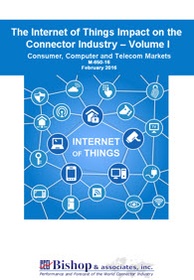By 2020 there will be more than 50 billion devices connected to the Internet in some way, shape, or form. While most of these “things” will be connected wirelessly, they will still give rise to equipment that communicates and saves all the data that is being collected.
 |
| Internet of Things (IoT) impact the connector industry |
How will the increase in equipment needed to support the Internet of Things (IoT) impact the connector industry?
Within the consumer, computer, and telecom sectors, what types of equipment will be impacted the most? Among connector types, which connectors will see the greatest growth and which connector types may see a decline in demand?
Which regions will most likely be affected by these changes, and will there be a switch in market dynamics as we see them today?
What role will technologies like near-field communications, RFID, Wi-Fi (including WiGig), and other wireless technologies like Visual Light Communication and TransferJet play in the growth of the IoT?
What data and telecom communication technologies have broadened and enhanced the host of mobile devices available today? What technologies lie on the horizon?
Focusing on the consumer, computer, and telecom equipment sectors, volume one examines the equipment and connector types within these sectors most likely to be influenced by the IoT. The report offers a quantitative analysis by region, sector, equipment type, and predominant connector type, allowing those most affected by the growth of the IoT to accurately position themselves. Don’t be caught offline – order your copy of The Internet of Things Impact on the Connector Industry – Volume 1: Consumer, Computer and Telecom.
Marketinfo Research announces the release of a new five chapter, 162 page research report analyzing the impact the Internet of Things (IoT) will have on the connector market. This first volume, which focuses on the consumer, computer and telecom market sectors, provides a look at the applications and connectors used in these applications that will most be influenced by the growth of the IoT.
 |
| IoT Connector Products Sold - Sales by Sector |
While the IoT is not quite at the level that Ashton envisioned yet, it is well on its way with a plethora of “things” being tracked. These “things” range from a Fitbit you wear on your wrist to track your health and fitness to tracking farmers’ tractors and everything in between. These “things” are pervasive in our everyday lives now and new ones are being invented at increasing rates.
The goal of this report is to explain the different IoT vertical markets and technologies and to detail the effects these may have on the connector industry. Chapter 2 of the report covers definitions that will be used throughout the report, and Chapter 3 highlights the wireless technologies and trends in the IoT market specific to telecommunications, computer and consumer devices. Detailed in Chapter 4 are IoT devices and applications and the specific connector products that are affected by them. In Chapter 5, five-year forecasts for these connectors segmented by region, market segment and Bishop’s traditional connector categories are provided. In addition, included are forecasts for specific connector product types that are poised for growth due to IoT applications. These include modular jacks used in networking applications; board-mount high-speed I/O; USB; micro-coax for smartphones; FPC/FFC used in portable devices; and HDMI used in HDTVs and displays.
The total market for IoT connector products sold into computer, consumer and telecom applications reached more than $14.5 billion in 2015 and is anticipated to grow significantly by 2020, resulting in substantial increases in a number of key connector products.








No comments:
Post a Comment